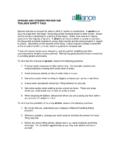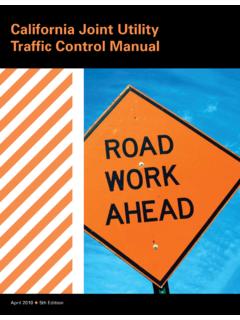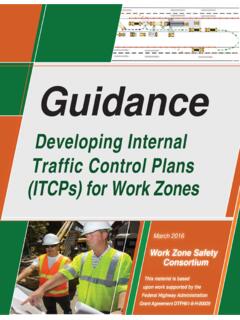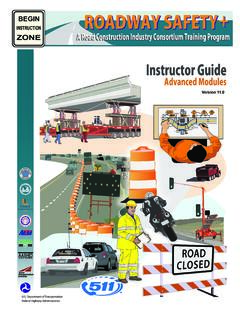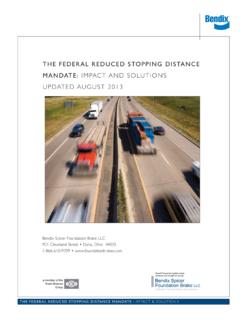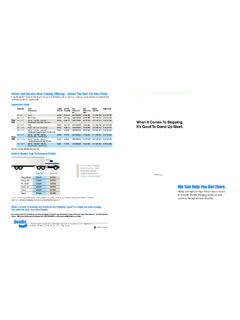Transcription of Guidelines on Work Zone Access and Egress
1 OnWork ZoneAccessandEgressGuidelinesThis document describes concerns associated with work zone accessand Egress . The document offers recommended practices and describeseffective strategies and techniques that can be employed during theplanning and construction phases to help mitigate document is organized into the following sections: Importance of work Zone Access and Egress Considerations Planning and Designing the work Zone to Minimize the Impact ofAccelerating and Decelerating Construction Vehicles on Traffic Flow Maintaining Access and Egress Points During Construction Incorporating Access and Egress into Internal Traffic Control Plans(ITCPs) with Examples of Innovative Ideas and Best Practices Median Access from Cross Street Overpass Use of Intelligent Transportation System (ITS)
2 Technology Incorporation of Construction Access and Egress Details into Project Plans_____Refer to for a copy of this on work Zone Access and EgressBackgroundThe establishment and maintenance of safe Access and Egress points are key determinants of project safety. Inorder for roadway construction jobs to maintain safe operations, there must be procedures to allow for safe andefficient passage of work vehicles into and out of the work space and for motorists to travel through the workzone. Effectively addressing safe Access and Egress at the project level requires planning during the project de-velopment phase and implementing traffic control plans throughout the entire project.
3 In December 2007, the Federal Highway Administration issued a new rule, 23 CFR 630 Subpart K, topromote safety for workers and motorists in roadway construction zones . One section of the new rule states, In addition to addressing risks to workers and road users from motorized traffic, the agency processes, proce-dures,and/or guidance ..should also address safe means for work vehicles and equipment to enter and exittraffic lanes and for delivery of construction materials to the work space, based on individual project charac-teristics and factors. Importance of work Zone Access and Egress ConsiderationsAccess to and Egress from highway con-struction and maintenance zones presentsa significant challenge to both travelersand work crews when the work is takingplace on or adjacent to a highway that isopen to traffic.
4 This is especially true ifthe highway carries high traffic volumesor traffic speeds are high. Safety challenges include: motorists following construction vehicles into the work space; acceleration and deceleration of construction vehicles as they exit andenter open traffic lanes; proximity of workers-on-foot to accessand Egress locations; and proximity of parked or staged equipmentto passing and Egress issues are most effectively addressed in the temporary traffic control (TTC) planning anddesign phase before construction begins. The designer should address how contractors will safely move per-sonnel, materials, and equipment into and out of the work area with minimum disruption to traffic and expo-sure of workers to the traveling proper planning is important, systematic reviews of changing conditions are also essential throughoutconstruction to ensure that planned Access and Egress points meet safety and mobility performance needs.
5 Thisreview process requires continued maintenance of all Access points, communication with personnel using accesspoints, and a mechanism to modify plans to rectify any Access or Egress problems that arise during construction. 1 Access / Egress CHALLENGES AND RECOMMENDED PRACTICESC hallenge 1: Planning and Designing the work Zone to Minimize the Impact on Traffic Flow from Accelerating and Decelerating Construction Vehicles Construction vehicles entering or exiting the work space can create significant speed differentials betweenthemselves and normal traffic using the facility. Large speed differentials have significant adverse effects onboth work zone capacity and work zone crashes and should be minimized as much as possible.
6 Access andegress considerations are particularly challenging in large-scale projects or on high speed/limited accesshighways. In addition, projects with significant roadside development and frequent driveway Access createconstruction vehicle acceleration and deceleration PracticesProject planners and work zone designers should strive to anticipateconditions requiring work vehicles to merge in/out of high-speedtraffic or work activities that will generate frequent delivery of materials ( , paving operations, bridge work , and aggregate work ).Planners must ensure adequate right-of-way is secured and obstaclesare identified to allow for safe vehicle operations into and out of theactivity area.
7 Depending on the work operation, planners should alsoconsider where vehicles waiting to deliver materials will be posi-tioned so that they are not queued in active travel lanes. A good practice is to observe and record site conditions and traffic patterns to plan for high traffic levels, peakperiod volumes, or potential crash areas and conditions that might arise if trucks begin to queue. Considerationshould also be given to road speeds, average daily traffic (ADT), and factors impacting construction vehicle ac-celeration and deceleration when interacting with traffic lanes. Further, Access and Egress locations should be planned and inte-grated in the TTC plan. Adequate acceleration/deceleration spacefor work vehicles should be provided and the location of accessopenings should meet the sight distance requirements as providedin stopping sight distance tables, such as Table 6E 1from the na-tional Manual of Uniform Traffic Control Devices(MUTCD).
8 Lane and/ or shoulder closures may be necessary to provide suffi-cient acceleration/deceleration space in these plans. Construction Access openings in temporary traffic barriers should be planned per state and/or Federal requirements to ensure that blunt ends of barrier wallsare properly protected. Channelization and delineation devices used in conjunc-tion with barriers should be planned ina manner that does not create a sightdistance problem for truck drivers, equip-ment operators, or motorists. Elevation differences between the travel lanes and the work space can adversely affect the speed at which construction vehicles can enter andexit the work space. Consequently, work zone designers should strive to2ble 6E-1.
9 Stopping Sight Distanas a Function of SpeedSpeed* Distance20 mph115 feet25 mph155 feet30 mph200 feet35 mph250 feet40 mph305 feet45 mph360 feet50 mph425 feet55 mph495 feet60 mph570 feet65 mph645 feet70 mph730 feet75 mph820 feet * Posted speed, off-peak 85th-percentile speed prior to work starting, or the anticipated operating speedTable 6E-1. Stopping Sight Distanceas a Function of Speed*Posted speed, off-peak 85th-percentile speedprior to work starting, or the anticipated operating speedkeep such elevation differences to a minimum. Access / Egress conditions may be further improved by loweringthe speed limit when work is active and then enforcing the speed limit.
10 Any reduction in the posted speedlimit should be authorized by the appropriate, responsible traffic engineer and based on an engineering study. Designers should also consider the possibility of motoristsmistakenly following construction vehicles into the workspace and take steps to prevent this confusion. A variety ofdevices or traffic control procedures should be consideredto improve safety and mobility near Access and egresspoints. Any changes to planned points should be coordi-nated with the TTC plan, Access / Egress controls, and drivernotification devices. Additional warning signs may be used to alert motoristsabout Access / Egress points when appropriate. These signsmay include static signs ( , TRUCKSENTERINGROADWAYorCONSTRUCTIONVEHIC LESONLY), static signs with flashing bea-cons, and Portable Changeable Message Signs (PCMS).

